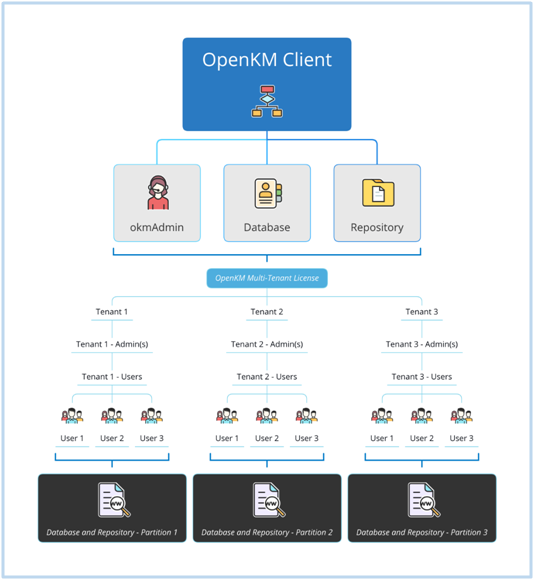- Call Us: +34 605 074 544
- Email us:

Be updated, subscribe to the OpenKM news
Multitenant Architecture

Written by Ricardo Álvarez, OpenKM USA staff member on 22 January 2021
Description & Integration
OpenKM’s multitenancy environment allows clients to divide a single instance of the OpenKM document management system into separate dedicated instances, called tenancies. All tenants access the same hardware and data storage servers while granting private access to each tenant’s unique system partition.
In other words, one software instance of OpenKM’s software runs on a single server, and multiple tenants access their specific sections of the multitenant database and repository. This leads to cost savings over running multiple instances of the software using economies of scale and shared maintenance costs.
Storage
All tenants store all information in a single application on a central server, sharing one repository and a single database for all clients.
Each tenant’s data is stored on a separate root directory and is invisible to the other tenants.
The physical information could be stored on a different mounted drive, allowing accurate physical disk usage to be derived by measuring the root location’s disk along with individual backup and recovery.
Cloud Environment
The benefits of multitenant architecture are also available on the Cloud. You can choose multitenant saas (software as a service) with OpenKM Cloud and we can also apply the benefits to software applications hosted with any cloud service provider.
No matter your cloud provider, the benefits of saas multitenant include not requiring the physical storage space or maintenance of servers, but saas vendors such as OpenKM offer additional assistance and expertise. Our saas application includes automatic backups for disaster recovery and performance analysis.
User Management & Registration
The client’s OpenKM Super Admin user account serves multiple tenants and looks after all network management with access to the entire multitenant application.
The Super Admin uses the Tenant Admin Console to create each tenancy and designate its administrators and users. Initial access control is applied at this time.
Once a tenancy is up and running, it is easy to add new administrators, multiple users and edit existing user privileges. This can be done by the Super Admin or by Administrators of a single-tenant if they have the necessary rights.
Architecture diagram

Customizations
Each tenant can customize the application’s look and feel. This includes folder structure, workflow customizations, document automations, web client UI, etc. A large benefit of multitenancy is the ability to utilize multiple database schemas on one application instance.
It is also possible to link specific folders from the different tenancies to exchange information or share files. This is most often utilized when one multitenant instance is serving multiple branches or different levels of the same organization.
Applications developers can create their own apps and extensions to OpenKM as well. OpenKM has a robust SDK and full API available to use in creating the perfect application for your needs.
Takeaway
OpenKM’s multitenancy model is one of the best near-term strategies to streamline a medium-to-large organization’s structure. It is particularly beneficial for businesses with multiple company-owned branches or those who need to grant separate repository access to independent users.
The diversification of a single OpenKM license provides multiple benefits:
- Lower cost from shared expenses across all tenants
- Simplified system update processes
- Easier document and data security management
- Enhanced system scalability

